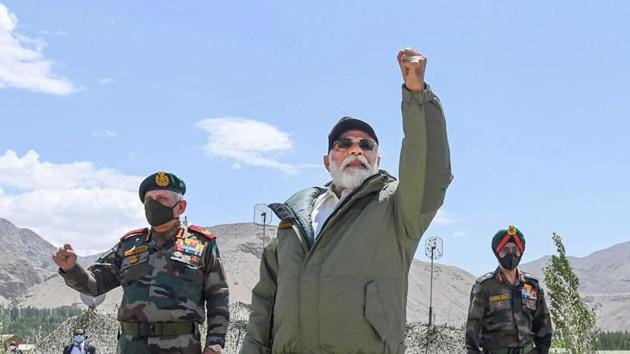How PM Modi called China’s bluff in Ladakh, writes Shishir Gupta
Xi Jinping is on an expansionist spree. But India has set the momentum for resistance. Others are joining in
After the successful outcome of the July 6 meeting between National Security Adviser and Special Representative for boundary talks, Ajit Doval, and his counterpart and Chinese foreign minister, Wang Yi, there has been a palpable lowering of tensions between the Indian and Chinese armies along the 3,488 km Line of Actual Control (LAC). The aggressive Chinese People’s Liberation Army (PLA) has thinned its presence at Finger Four in Pangong Tso, has withdrawn from forward positions to base camps in the Galwan sector, and is on the way back to its April positions in the Gogra and Hot Springs area. Disengagement has begun with de-escalation to follow in next three weeks — three divisions (30,000 troops) each of the Indian and Chinese armies are still facing each other from Ladakh to Arunachal Pradesh.

There is a certain amount of satisfaction among national security planners that the Indian military stood up to PLA, but the massive bilateral erosion of trust after the June 15 flare-up has convinced the Narendra Modi government that Beijing will be back on LAC, perhaps at Depsang Plains in Ladakh, next summer. For a country which believes that it is a global superpower, 2017 Doklam and 2020 Galwan are mere tactical mistakes in power projection and ambition.
That Prime Minister (PM) Modi will think a hundred times before he does a Wuhan or Chennai connect again with paramount leader Xi Jinping is akin to a traffic ticket for the Middle Kingdom. For a rampaging China, it is only the big picture that matters.
The Chinese expansionist posture in Ladakh is intertwined with the country’s plans in the South China Sea — something that is evident by looking at the world map. Beijing wants the Shyok river alignment to be the border with India in Ladakh so that the multi-billion dollar China-Pakistan Economic Corridor is further away from the Indian military positions, and also to ensure it gets a better all-weather route linking the Tibet Highway in Aksai Chin to the Karakoram highway south of the Khunjerab pass.
With Pakistan now reduced to a client State of China, it is through the port of Balochistan that the PLA Navy will dominate the oil trade in the Persian Gulf and the Arabian Sea. The Chinese base in Djibouti and Beijing’s huge influence on Africa’s eastern seaboard will allow it to dominate the sea route from Suez Canal. The strategic location of both the Gwadar and Djibouti bases makes this amply evident to any military planner.
The Chinese military’s ambition in the South China Sea is not only limited to dominating more than half of world trade passing through the Malacca, Lombard and Sunda Straits, but to also capture Taiwan as part of One China Policy to, then, break out from its backyard and contest the dominance of the Pacific Ocean with the United States (US) Japan and Australia. The military key to this posture is the presence of ballistic missile firing Chinese nuclear submarines at Yulin Naval Base at Hainan Islands, just north of Vietnam.
As a military plan, all this looked good and achievable, till such time India, under PM Modi, called the Ladakh bluff and the mighty US Navy simultaneously pincered Beijing by challenging the PLA Navy in the South China Sea. Currently, supercarriers USS Ronald Reagan and USS Nimitz are not only orchestrating a full spectrum war game in the South China Sea but also daring Beijing’s mouthpieces who threaten to use DF-21 D and DF-26 “ship killer” nuclear missiles on carriers. The US task forces now dominate all the exit routes from the East and South China sea in Miyako, Bashi Channel and Luzon Strait through which the global internet cables pass undersea.
Asean countries are also unhappy with China, and Japan is finally standing up to Beijing in the Senkaku Island dispute. Australia and Canada have called out China, and Europe has finally woken up to the reality of a Communist State. If one were to look at the big picture, then the global pushback against China was inspired by the Galwan fightback and followed by US President Donald Trump translating America’s often stated but never implemented Asian Pivot objectives on the sea. The plight of the Buddhist people of Tibet and Muslim Uighurs in Xinjiang under the traditionally xenophobic Han Chinese is back on the global agenda, and suddenly things don’t look so good for the general secretary of the Chinese Communist Party.
Rather than distracting countries from the global fight against the marauding coronavirus, which originated from Wuhan, by indulging in a war dance in Ladakh and the South China Sea, China should be at the forefront of the battle against the pandemic. It needs to de-escalate from both the areas and not wait for another opportunistic strike when the world is focused on US Presidential elections in November 2020 as it did against India in 1962 taking advantage of Cuban Missile Crisis.
Taking a leaf out of past paramount rulers, China needs to settle the borders on basis of the 2005 agreement on the Political Parameters and Guiding Principles of the India-China Boundary Question. President Xi surely understands the popularity of Modi, whom much of India followed faithfully through the painful demonetisation and total lockdown. But the global bully that China has become, it understands only the language of power, and the economic, military might and technological superiority of the US. Had the India-US nuclear deal been nixed by opponents in India, the 2005 border agreement would have never come through. Beijing will not forget 2020, the year of the metal rat in the Chinese calendar, in a hurry. The world, particularly India and the happy tiny kingdom of Bhutan, will hear the echoes of this in the future.




